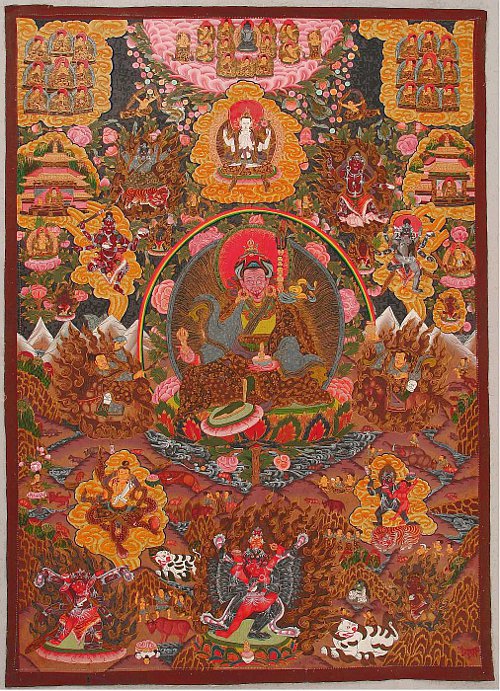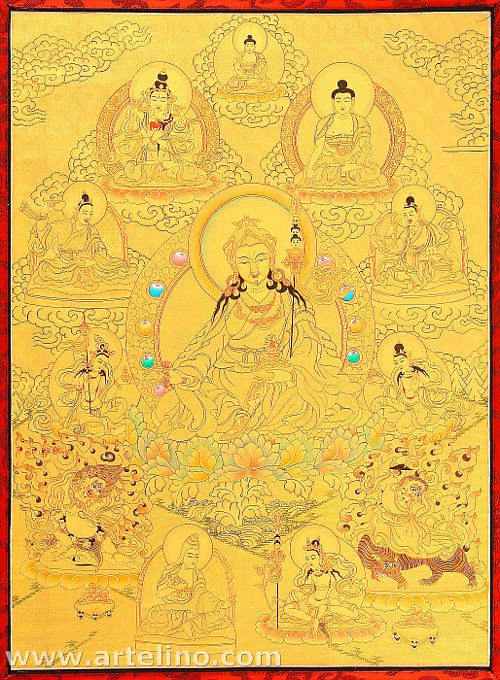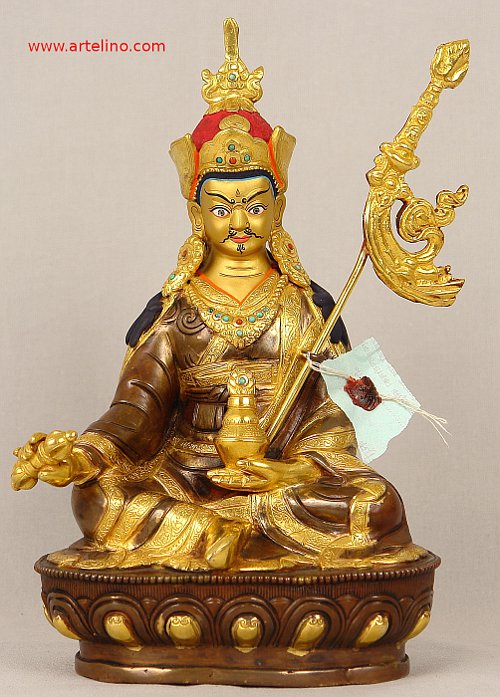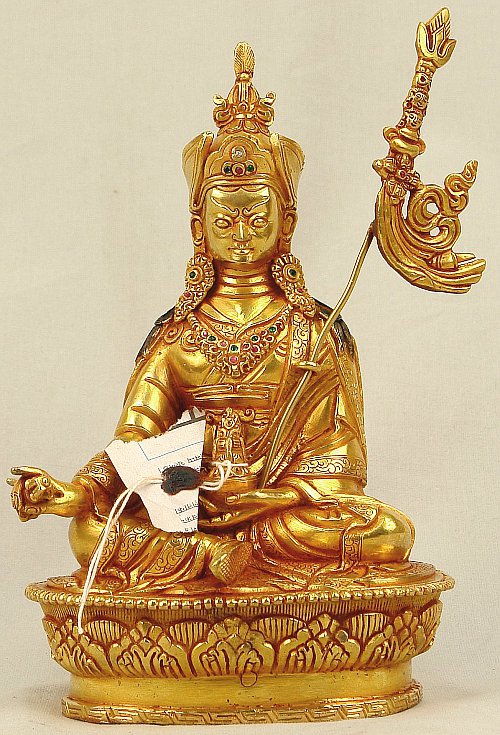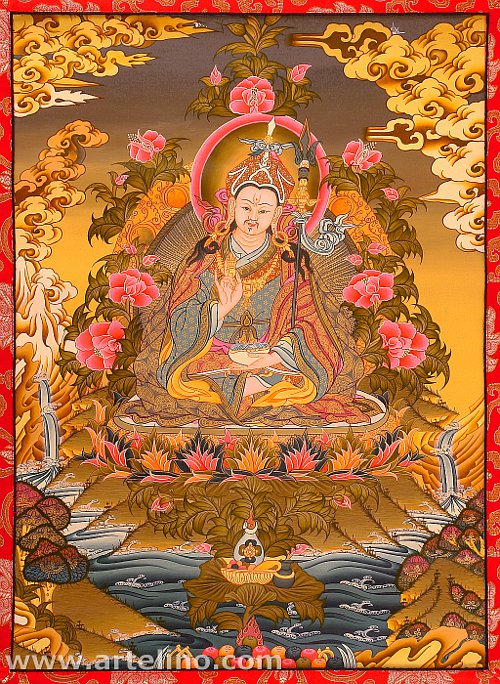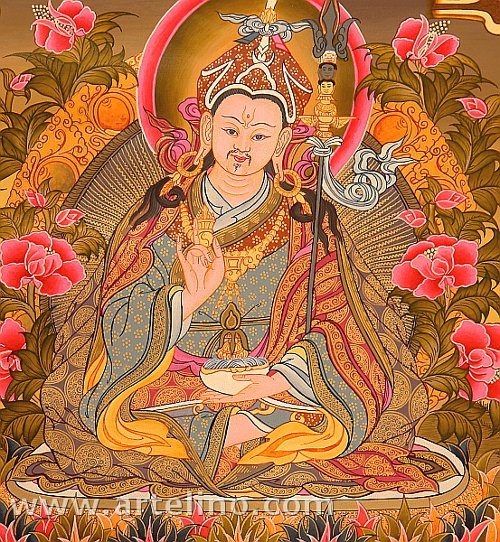| < Prev |
|---|
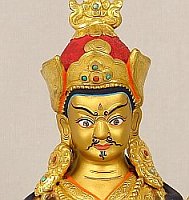 Padmasambhava is one of the popular characters depicted on Himalayan art and artisan objects. For beginners he is fortunately rather easy to recognize with his typical face, accessories and posture. But who was he?
Padmasambhava is one of the popular characters depicted on Himalayan art and artisan objects. For beginners he is fortunately rather easy to recognize with his typical face, accessories and posture. But who was he?
The Historic Padmasambhava
Padmasambhava is a historic figure who became part of the pantheon of gods and goddesses of Buddhism. He was born somewhere in the area of Northern India, Pakistan or Afghanistan in the 8th century. Although he was still very young, he had soon acquired a reputation as a saint and guru of tantric Buddhism.
Mission in Tibet
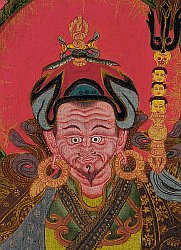 One day the Tibetan king Trisong Detsen, 742-798, (Nepali: Thi-Sron Detsan) invited him to come to Tibet. According to the legend Tibet was then haunted by evil mountain spirits. Meant is presumably the old animistic Bön tradition and religion. Padmasambhava remained in Tibet for up to 50 years. This is however very much disputed among scientists. The guesses are from several months up to these 50 years.
One day the Tibetan king Trisong Detsen, 742-798, (Nepali: Thi-Sron Detsan) invited him to come to Tibet. According to the legend Tibet was then haunted by evil mountain spirits. Meant is presumably the old animistic Bön tradition and religion. Padmasambhava remained in Tibet for up to 50 years. This is however very much disputed among scientists. The guesses are from several months up to these 50 years.
Padmasambhava introduced tantric Buddhism in Tibet, founded monasteries and spent his time teaching. The first monastery of Tibet founded by him was Samye, designed after the pattern of a Mandala. On the day of the inauguration ceremony for the monastery, all kind of magic things happened. The stone statues became alive and the bronze dogs at the door entrances began to bark.
The legend says that Padmasambhava defeated all the evil spirits and foes of Buddhism. But he spared those who surrendered and converted to Buddhism and promised to become defenders of the tantric doctrines. Such tactics are smart and have always worked well since the times of the old Romans. But too little is known about the historic Padmasambhava, and we do not know if these tales actually had a background of militant campaigns against hostile tribes or other kingdoms.
Padmasambhava must have had great power and influence at the court of the Tibetan king. This obviously also made him many foes among the aristocracy and the people. It is said that he may even have been exiled for a short period. Another source of trouble may have been his extensive love life. There are at least 5 known female "consorts", all of high aristocratic stand and some even being the wives of others. Sounds like a high-grade source for potential trouble.
Different Names
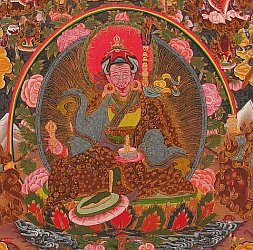 As applies for so many saints and deities of the Buddhist and Hindu pantheon, you encounter also the "Lotus Born" with different names. Padmasambhava is also called Guru Rinpoche. In Nepalese he is written as Padma Sambhav. Usually you can find the same character with different names in Hindi, Tibetan, Chinese and Nepalese. This makes the understanding of the Buddhist pantheon somewhat confusing by nature.
As applies for so many saints and deities of the Buddhist and Hindu pantheon, you encounter also the "Lotus Born" with different names. Padmasambhava is also called Guru Rinpoche. In Nepalese he is written as Padma Sambhav. Usually you can find the same character with different names in Hindi, Tibetan, Chinese and Nepalese. This makes the understanding of the Buddhist pantheon somewhat confusing by nature.
Hidden Treasures?
Guru Rinpoche's knowledge of efficient practices of tantric secrets gave him supernatural powers according to the legends. Being convinced that tantric Buddhism could degenerate in the future, he buried his wisdom and knowledge as secret books and other treasures at unknown places like in mountain caves so that future generations might find them one day.
It is said that Guru Rinpoche left Tibet one day towards the 'Tibetan-Nepalese border region in the Himalayan mountains and simply disappeared. The legend says that he rode on a sun ray towards heaven.
Padmasambhava in Tibetan and Nepalese Arts
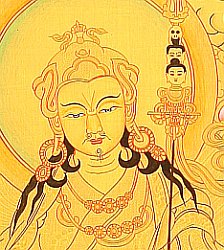 Guru Padmasambhava is a popular character on Tibetan and Nepalese thangka paintings and for metal statues. When you have seen a few depictions of him, it is rather easy even for beginners to recognize him.
Guru Padmasambhava is a popular character on Tibetan and Nepalese thangka paintings and for metal statues. When you have seen a few depictions of him, it is rather easy even for beginners to recognize him.
Guru Rinpoche is usually shown sitting on a lotus throne with his legs crossed. In his right hand he is holding a "vajra", the symbol for the thunderbolt. The left hand rests in his lap and holds a "patra", a kind of beggar's bowl. And with his left arm he presses a long ornamental stick against his shoulder. It is called "khatvanga". Needless to say that these three accessories have a deeper meaning, which we skip to explain on this introduction page.
Also the face has typical characteristics. Padmasambhava is shown with rather large eyes compared to other Himalayan gods, goddesses and saints. He is always shown with a rather peculiar mustache and a strange cap. Take a look at the images on this page. And I am sure that you will recognize him when you will see him next time somewhere else.
Padmasambhava - Gallery
Dieter Wanczura




